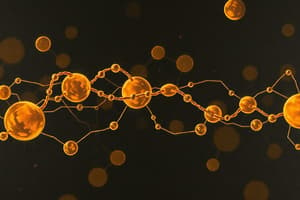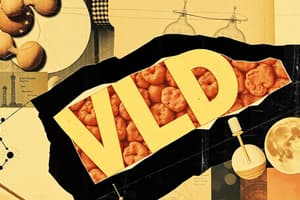Podcast
Questions and Answers
Which of the following best describes the primary function of lipoproteins?
Which of the following best describes the primary function of lipoproteins?
- To synthesize cholesterol in the liver.
- To regulate the production of bile acids.
- To transport lipids in the blood plasma. (correct)
- To directly lower blood glucose levels.
Which apolipoprotein is associated with an increased risk of coronary heart disease?
Which apolipoprotein is associated with an increased risk of coronary heart disease?
- Apolipoprotein A-1
- Apolipoprotein B-100 (correct)
- Apolipoprotein C-II
- Apolipoprotein E
Which of the following processes is directly facilitated by the action of lipoprotein lipase on chylomicrons?
Which of the following processes is directly facilitated by the action of lipoprotein lipase on chylomicrons?
- Direct conversion of LDL to HDL
- Delivery of triglycerides to peripheral cells (correct)
- Increased cholesterol synthesis in the liver
- Inhibition of bile acid reabsorption
The reverse cholesterol transport pathway is important for preventing atherosclerosis. Which of the following is a key component of this pathway?
The reverse cholesterol transport pathway is important for preventing atherosclerosis. Which of the following is a key component of this pathway?
Elevated LDL-cholesterol levels are a major risk factor for cardiovascular disease. Which of the following conditions is most closely associated with these elevated levels?
Elevated LDL-cholesterol levels are a major risk factor for cardiovascular disease. Which of the following conditions is most closely associated with these elevated levels?
Which of the following is the primary mechanism of action of statins in treating dyslipidemia?
Which of the following is the primary mechanism of action of statins in treating dyslipidemia?
Fenofibrates are used to treat dyslipidemia. How do fenofibrates primarily function to lower triglyceride levels?
Fenofibrates are used to treat dyslipidemia. How do fenofibrates primarily function to lower triglyceride levels?
Niacin is known to affect lipid levels. What is the primary mechanism by which niacin raises HDL levels?
Niacin is known to affect lipid levels. What is the primary mechanism by which niacin raises HDL levels?
Cholestyramine is a bile acid sequestrant used to lower cholesterol. How does cholestyramine achieve this effect?
Cholestyramine is a bile acid sequestrant used to lower cholesterol. How does cholestyramine achieve this effect?
Ezetimibe is a medication that inhibits the absorption of cholesterol. Which specific protein does ezetimibe target to achieve this?
Ezetimibe is a medication that inhibits the absorption of cholesterol. Which specific protein does ezetimibe target to achieve this?
Which of the following apolipoproteins regulates HDL metabolism and reverses cholesterol transport?
Which of the following apolipoproteins regulates HDL metabolism and reverses cholesterol transport?
Which of the following lipoproteins are considered atherogenic due to their role in plaque formation?
Which of the following lipoproteins are considered atherogenic due to their role in plaque formation?
In the exogenous pathway of lipoprotein metabolism, what is the initial step that occurs in the intestine?
In the exogenous pathway of lipoprotein metabolism, what is the initial step that occurs in the intestine?
Which process describes how peripheral cells accumulate cholesterol from circulating lipoproteins?
Which process describes how peripheral cells accumulate cholesterol from circulating lipoproteins?
Which of the following cellular components plays a critical role in efficiently moving cholesterol out of macrophages to prevent atherosclerosis?
Which of the following cellular components plays a critical role in efficiently moving cholesterol out of macrophages to prevent atherosclerosis?
What is the role of ApoB in the context of diagnosing dyslipidemia variants?
What is the role of ApoB in the context of diagnosing dyslipidemia variants?
Which of the following best describes the effect of adiposopathy on VLDL levels?
Which of the following best describes the effect of adiposopathy on VLDL levels?
What is the primary mechanism by which cholesterol ester transfer protein (CETP) affects lipoprotein metabolism?
What is the primary mechanism by which cholesterol ester transfer protein (CETP) affects lipoprotein metabolism?
Which of the following is a common adverse effect associated with nicotinic acid (niacin) when used to treat dyslipidemia?
Which of the following is a common adverse effect associated with nicotinic acid (niacin) when used to treat dyslipidemia?
During the endogenous pathway of lipoprotein metabolism, what is the fate of LDL?
During the endogenous pathway of lipoprotein metabolism, what is the fate of LDL?
Flashcards
Lipoprotein
Lipoprotein
Any group of soluble proteins that combine with and transport lipids in blood plasma, serving as carrier molecules for hydrophobic lipids.
Apolipoprotein
Apolipoprotein
Proteins that bind lipids to form lipoproteins, regulating lipoprotein metabolism and influencing vascular biology.
LDL (Low-Density Lipoprotein)
LDL (Low-Density Lipoprotein)
Increases the risk of coronary heart disease, transports cholesterol from the liver to the body.
HDL (High-Density Lipoprotein)
HDL (High-Density Lipoprotein)
Signup and view all the flashcards
Apolipoprotein B-100
Apolipoprotein B-100
Signup and view all the flashcards
Apolipoprotein A-1
Apolipoprotein A-1
Signup and view all the flashcards
Exogenous Pathway
Exogenous Pathway
Signup and view all the flashcards
Endogenous Pathway
Endogenous Pathway
Signup and view all the flashcards
Reverse Cholesterol Transport
Reverse Cholesterol Transport
Signup and view all the flashcards
Dyslipidemia
Dyslipidemia
Signup and view all the flashcards
Adiposopathy
Adiposopathy
Signup and view all the flashcards
Atorvastatin (statins)
Atorvastatin (statins)
Signup and view all the flashcards
Fenofibrate (fibrates)
Fenofibrate (fibrates)
Signup and view all the flashcards
Nicotinic acid/Vit B3
Nicotinic acid/Vit B3
Signup and view all the flashcards
Cholestyramine
Cholestyramine
Signup and view all the flashcards
Ezetimibe
Ezetimibe
Signup and view all the flashcards
Study Notes
Lipoproteins
- Have a hydrophobic core of cholesterol ester and triglycerides
- Have a periphery composed of ApoA-I, ApoE, ApoC, ApoA-II, and unesterified cholesterol
Lipoprotein vs Apolipoprotein
- Lipoproteins contain a group of soluble proteins that combine with and transport lipids in blood plasma
- They act as carrier molecules for hydrophobic lipids
- They are synthesized in the liver
- They are composed of a phospholipid and cholesterol outer shell, and a hydrophobic core of cholesterol esters and triglycerides
- Classes include HDL, LDL, IDL, VLDL, and ULDL
- LDL increases the risk of coronary heart disease
- HDL lowers the risk of coronary heart disease
- Apolipoproteins are proteins that bind lipids to form lipoproteins
- They consist of proteins bound to phospholipids
- They regulate lipoprotein metabolism and influence normal human vascular biology and the development of atherosclerotic cardiovascular disease
- They are synthesized in the liver and intestine
- Classes include apolipoprotein A, B, C, D, E, H, L, and a
- Apolipoprotein B-100 increases the risk of coronary heart disease
- Apolipoprotein A-1 lowers the risk of coronary heart disease
- It regulates HDL metabolism and reverses cholesterol transport
- Apo B-100, Apo B-48, and Apo a form the structural backbone of atherogenic lipoproteins like VLDL, IDL, LDL, chylomicrons, and lipoprotein a
- Apo C-II, Apo C-III, and Apo E regulate triglyceride-rich lipoprotein metabolism
- Apolipoproteins serve as structural components in lipoproteins, ligands for surface receptors, and cofactors for enzymes involved in lipid metabolism
Lipoprotein Metabolism - Exogenous Pathway
- Begins in the intestine with the absorption of dietary fats (FFA and cholesterol)
- Chylomicrons lose triglyceride due to lipoprotein lipase, becoming chylomicron remnants
- These remnants are then taken up by the liver
- Triglycerides are delivered to peripheral cells
- Some cholesterol is used to synthesize bile
Lipoprotein Metabolism - Endogenous Pathway
- Begins in the liver
- Triglycerides and cholesterol are used to synthesize VLDL
- Some VLDL lose FFA to peripheral tissue and become IDL
- IDL may lose some FFA and become LDL
- LDL is taken up by the liver, which extracts cholesterol from it
Lipoprotein Metabolism - Reverse Cholesterol Transport
- Peripheral cells accumulate cholesterol by taking up circulating lipoproteins
- Cholesterol taken up by HDL is released to the liver
- The level of cholesterol biosynthesis depends on the amount of cholesterol released into the liver by LDL and HDL uptake
- Macrophages' ability to efficiently efflux cholesterol into the reverse cholesterol transport pathway is important in preventing atherosclerosis
- Transporters like ABCA1, ABCG1, and SR-BI on macrophages break down fat to free cholesterol
- ABCA1 transports to discoidal HDL
- ABCG1 and SR-Bi transport to mature HDL
- Mature HDL can either become cholesterol ester and then VLDL, or directly deliver cholesterol ester to the liver
- ApoA1 from intestines/liver becomes discoidal HDL and then mature HDL via lecithin cholesterol acyltransferase (LCAT)
- Transporters like ABCA1, ABCG1, and SR-BI on macrophages break down fat to free cholesterol
Dyslipidemia
- It is a metabolic disorder characterized by elevated LDL-cholesterol levels, which is a major risk factor for cardiovascular disease
- Can be genetically determined, or secondary to other conditions like diabetes M, obesity, or an unhealthy lifestyle
- LDL cholesterol levels are important in diagnosing familial hypercholesterolemia
- ApoB is diagnostic in mixed dyslipidemia
- Adiposopathy results in increased FFA release, contributing to fatty liver and increased VLDL
- VLDL can become HDL and LDL through metabolic processes involving cholesterol ester-transfer protein (CETP)
- HDL is more easily metabolized and cleared by the kidneys
- LDL may be more atherogenic
Drugs for Dyslipidemia
- Atorvastatin (statins)
- Are HMG-CoA reductase inhibitors
- Decrease the amount of LDL and TG in the blood
- Increase the amount of HDL in the blood, but minimally
- Rosuvastatin may increase HDL levels more effectively
- Reduce cholesterol synthesis in the liver
- Less cholesterol synthesis results in more LDL uptake and less VLDL secretion
- Adverse effects may include myalgia, myostitis/rhabdomyolysis, and transaminitis
- Fenofibrate (fibrates)
- Are antilipemic agents
- Are PPAR-ɑ agonists
- Speed up the natural process of removing cholesterol from the body by reducing cholesterol and TG in the blood
- They increase the breakdown of TG in VLDL and chylomicrons, which in turn lowers TG levels
- They decrease VLDL synthesis due to lower TG availability
- They increase apoA synthesis, which mildly increases HDL
- Adverse effects include myalgia, rhabdomyolysis, cholelithiasis, and elevations in serum creatinine
- Nicotinic acid/Vitamin B3 (niacin)
- Raises HDL and lowers LDL by inhibiting VLDL secretion
- Decreases lipoprotein a
- Adverse effects may include flushing/vasodilation, impaired insulin sensitivity, gout, and gastritis
- Cholestyramine (bile acid sequestrant)
- Is a bile acid-binding resin
- Is strongly positively charged and binds negatively charged bile acids in the intestines, blocking their reabsorption and inhibiting enterohepatic circulation
- Adverse effects may include increased TG, bloating/constipation, and interference with the absorption of other medications like levothyroxine, warfarin, and digoxin
- Ezetimibe (cholesterol absorption inhibitor)
- Inhibits NPC1L1 in the intestines to block cholesterol absorption from foods and inhibits the reabsorption of cholesterol ready to be excreted
- May be used alone or in combination with a statin
- Lowers LDL and TG
- Adverse effects include myalgia and rhabdo, though these are very rare
Studying That Suits You
Use AI to generate personalized quizzes and flashcards to suit your learning preferences.



